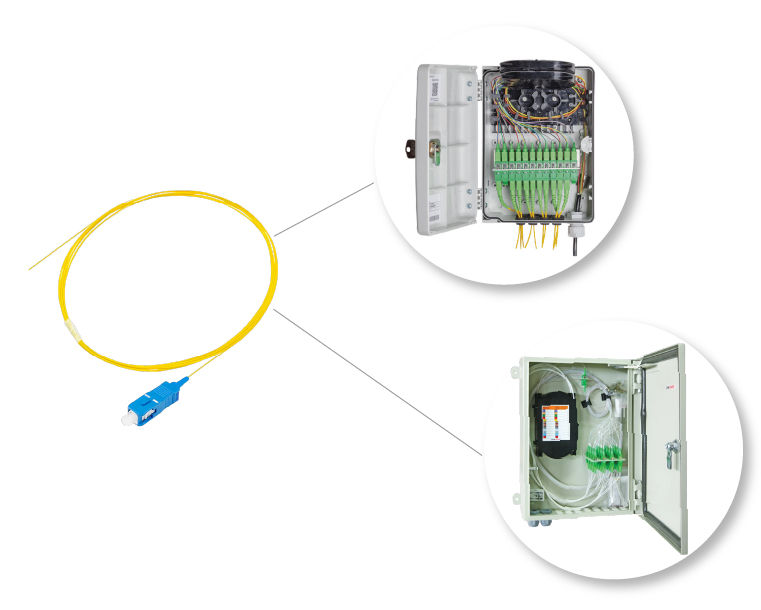Cable & Wire | High quality and excellent service at reasonable prices.
info@zion-communication.com
Author: James Publish Time: 17-07-2025 Origin: Site
Optical fiber pigtails refer to short fiber lines with a terminator factory fixed with a high-precision optical connector on one side and bare on the other for splicing. They act as the crucial compartments on the fiber optic network by connecting optical cables with the active/passive equipment, which assists the fiber optic networks to function efficiently.

Fiber Optic Pigtails: One-side connector types, in contrast to fusion and mechanical span, elementary. Conventionally, they don't have any outer jacket or in minimal stages, which allows splice tray management.
Fiber Optic Patch Cords: Ending with the two connectors enables you to plug it into a patch panel or any device for ready use.
Making the difference between the two is necessary for the network systems design as well as installation pipeline.
The ZION Communication brand assures pigtails with industry standards for compatibility and performance in every aspect:
Single Mode (SM): G.652.D (OS2), G.657.A1 & G.657.A2 fibers for low attenuation and low dispersion, which are suitable for long-haul routes and FTTH networks.
Multimode (MM): OM1 (62.5/125μm) is in conformity with enterprise LAN and data center systems, which have high bandwidth requirements for short distances.
Polish grades (choices) and connector options (e.g. LC, SC, FC, ST – the most common connector types in telecom, datacom, and CATV) affect insertion loss and return loss characteristics:
Polish Types:
UPC (Ultra Physical Contact): A low reflection level usually above -55 dB is the specification for the majority of telecom and data networks.
APC (Angled Physical Contact): The end-face of the fiber is angled at (approx. 8°) to lessen the back reflection by < -65 dB, differentiating APC from PMP and SC connectors. Such specification is critical for WDM, CATV, and Analog applications.

Taking into account the space, environment, and application among the factors influencing the selection of the cable jacket and the fiber count we have:
Jacket Materials:
PVC: Most typical for indoor use with satisfactory flexibility.
LSZH (Low Smoke Zero Halogen): Legally mandated for fire safety conformity in small closed spaces or public settings.
Fiber Count:
Simplex (1 fiber): Used when a direct (1-to-1) connection to equipment or patching panels is required.
Bunch/Bundle (typically 12 fibers): Suitable for high-density splicing and ODF management.
Bunch Fiber Optic Pigtails (12 Fibers)
Designed for efficient mass splicing and fiber management with color-coded fibers per TIA/EIA-598-A standards.
SKU | Connector | Fiber Type | Jacket | Polish | Notes |
7242201 | LC UPC | PVC 0.9mm | UPC | Standard indoor version | |
7242202 | LC UPC | Bare | UPC | For splice tray use | |
7242203 | LC UPC | PVC 0.9mm | UPC | For short-reach LAN | |
7242204 | SC UPC | PVC 0.9mm | UPC | Alternate connector type | |
7242205 | SC UPC | Bare | UPC | Bare fiber for splicing | |
7242206 | SC UPC | PVC 0.9mm | UPC | Multimode, PVC jacket |
Simplex Fiber Optic Pigtails (1 Fiber, 2m Standard Length)
Ideal for point-to-point terminations requiring minimal space and straightforward installation.
SKU | Connector | Fiber Type | Polish | Application Notes |
7242207 | LC UPC | UPC | Typical telecom use | |
7242208 | LC UPC | UPC | Data center, LAN | |
7242209 | LC APC | APC | High performance WDM | |
7242210 | LC APC | APC | Specialized multimode use | |
7242211 | SC UPC | UPC | Equipment termination | |
7242212 | SC UPC | UPC | Multimode simplex | |
7242213 | SC APC | APC | High reflection sensitive | |
7242214 | SC APC | APC | Multimode APC polish | |
7242215 | ST UPC | UPC | Legacy systems | |
7242216 | ST APC | APC | Specialized use cases |
Information and procurement specialists should highlight:
Network architecture: Single mode for long distance, multi mode for MAN and LAN.
Interconnectivity with the connectors’ type: To confirm connector type with equipment ports.
Insertion Loss & Return Loss Requirements: Polish types should be chosen with understanding (UPC vs APC).
Environmental conditions: Choose the fabric type so that it is in agreement with the assumed protection standard of local regulations.
Quantity and packaging: Cost-efficient bulk order option with your own branded label and packaging to fit your operational process.
Length specifications: Either the standard length of cables used in the installation design or customized cables.
Optical Distribution Frame (ODF) terminations
Fiber to the Home/Building (FTTH/FTTB) extending
Backbone and cross-connect of data center
RF fiber and CATV fiber links
Setups for measuring and testing equipment
Military and industrial fiber network outer-users; versions ruggedized
Direct factory supply system without any intermediary, builds advantage in cost and quality control.
In-depth product line satisfies technical diversity.
Utilize in-house professional technical consultation guarantees the right solution for optimization.
There is also a possibility of custom OEM services, packaging, or labelling.
They are consistent for delivering, with steady and fulfilling schedule too.
On the other hand, the technical specification comes with the details of connector type, fiber mode, jacket, polish, length and quantity.
Send a formal proposal: The ZION sales team recommends individual product solutions (policy) and quotations.
And also: order confirmation and preparation, follow-up with the actual start-up date of production, day 25 post deposit.
Regular support: technical and logistics support after sales.

James is a technical manager and associate at Zion Communication.
Specializes in Optical Fiber communications, FTTH Solutions,
Fiber optic cables, ADSS cable, and ODN networks.
james@zion-communication.com
+86 13777460328
